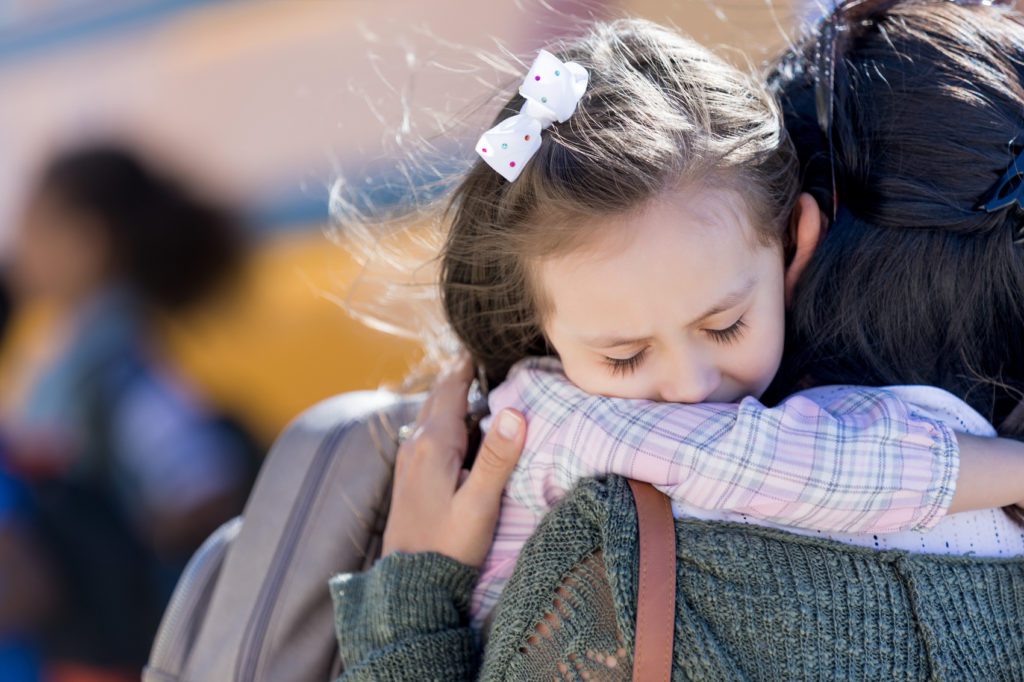6 Teacher-Approved Tips to Help Children Tackle Separation Anxiety

Separation anxiety is common in young children. It typically begins around 6 months of age and is often resolved by the time a child is 3 years old. But that’s not always the case, and even children who have grown accustomed to their drop-off routines and happily jet off to school may find themselves clinging to their family members after an extended holiday at home.
From temper tantrums to acting withdrawn, separation anxiety can manifest itself in an array of ways. The good news? There are steps teachers can take to help children cope with separation anxiety and, eventually, make drop-off a breeze.
To explore some of those steps, we turned to The Hub, our online community of early childhood educators, and rounded up six teacher-approved tips for tackling separation anxiety.
1. Team up with families for a successful drop-off routine.
When Mckeeba L., an early learning teacher and a professional development network trainer in North Carolina, noticed one of the young learners in her class struggling with drop-offs, she teamed up with their mom. Here’s what worked for them.
“I would be at the door for support, and Mom would give words of reassurance with lots of hugs and kisses. Mom would stay with the child for the question of the day; attendance; and, lastly, their very own ‘time to let mommy go’ action. Some days did not go as smoothly as others. If Mom needed support, she would use a specific action word to signal me to jump in with words of reassurance followed by hugs and kisses.”
Ultimately, Mckeeba believes the secret to a successful drop-off routine is time. She encourages families to give themselves enough time in the mornings to ensure drop-off is a calming process instead of a rushed and stressful experience.
2. Focus on the power of words.
Separation anxiety is a sign that a child needs comforting, so be careful not to simply distract or trick the child during drop-off to prevent them from being upset. When working with young learners who are struggling with separation anxiety, teachers should let the children talk about what’s upsetting them and validate their feelings while also helping them learn to navigate strong emotions.
For example, a child’s teacher and family could help the child choose a phrase they can use as part of a self-soothing strategy when they miss their family, such as, “After school, I go home to my family.” A calming affirmation like this one, paired with the teacher’s gentle reminder that it’s normal to feel sad when children are apart from their families and that he is there to take care of them until their families pick them up at the end of the school day, helps some children feel less anxious.
Speaking of helpful words, Tisha T., an early childhood educator in Alabama, encourages children to say “see you later” to their families instead of “bye,” which can feel more final. “See you later” vs. “goodbye” may seem like a small distinction to make, but this subtle yet intentional change provides children with reassurance that their families will return.
3. Use comfort items.
Colette V., a preschool teacher in New Jersey, has found that comfort items make a big difference to anxious children.
“Ask the child’s parent or guardian to bring in a family picture or a picture of a special place their child enjoys visiting and then place the image in a plastic frame for the child to hold,” she said.
Teachers can also ask families to bring in a stuffed animal or a special blanket for their child or put a loved one’s photo in a necklace for the child to wear. Some teachers even create big family trees with pictures of each child’s family so the children feel the presence of their loved ones in the classroom.
Tiffany A., who works for the Oregon Department of Education, has used comfort items to create calm corners where children can be alone and decompress. She recommends including items such as toys, pillows, relaxing pictures, emotion charts, and engaging books.
4. Harness the magic of puppets.
It’s no secret that children love puppets. Colorful, playful, and comforting, puppets are less intimidating than adults for children, which make them ideal for soothing young learners. Just ask Dorothy F., an early childhood educator in Colorado.
Explaining that “sometimes children listen to what a puppet has to say before anyone else,” Dorothy used a Chester Raccoon finger puppet while reading The Kissing Hand—a story about a young raccoon named Chester who is afraid to go to school and be away from his mom for the first time. “Chester loved to ‘talk’ with the children about how he had to overcome his feelings of fear, too,” Dorothy said.
Puppets have worked wonders in Wendy D.’s classroom as well. As a preschool teacher in Florida, she uses puppets to help children feel like they have a best friend in the classroom and make drop-offs less intimidating.
5. Make a visual calendar.
Uncertainty can fuel separation anxiety. When children are being dropped off, they aren’t always sure when they’ll see their families again, which makes it harder to say goodbye—or “see you later.” That’s where a visual calendar can help.
Several teachers recommend using a picture schedule to help children know when they’ll be reunited with their families and allow them to count down to pick-up time, helping ease their uncertainty.
6. Dole out extra TLC.
Children with separation anxiety can often feel lonely and nervous in the classroom. Teachers can alleviate these negative emotions by paying extra attention to the child. You can ask them to help set up an activity or give them a special job, as Tisha T. does.
You can also sit on the floor and calmly talk with the child, which is what Karen W., an early childhood educator in Missouri, sometimes does. “Even sitting in silence and reminding the child that their mom or dad always comes back seems to help a lot,” she said.
There is no quick fix or one-size-fits-all solution for separation anxiety. But by trying different methods and finding the ones that work for each child, teachers can help children go from crying to feeling comfortable in the classroom.

Join Discussions with Real Teachers
Teachers with access to the Teaching Strategies platform can ask questions and join in conversations with other educators in The Hub.